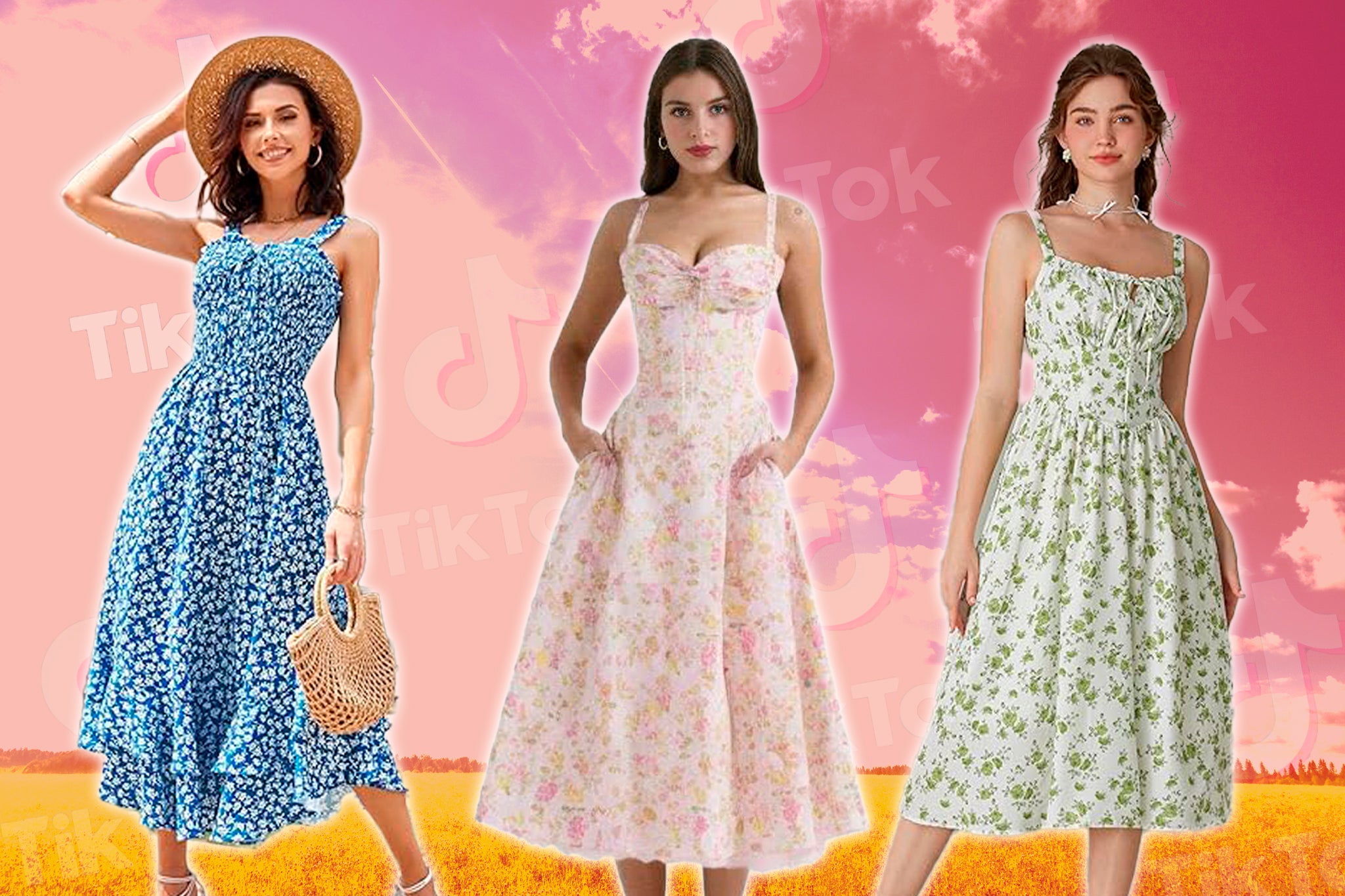The Independent's journalism is supported by our readers. When you purchase through links on our site, we may earn commission.
‘Sundress season’ isn’t for women. How men on TikTok are exposing our backwards notions of femininity
As men on TikTok praise the return of ‘sundress season,’ a viral debate has asked what sundresses actually are and who they’re really for. Meredith Clark unpacks the furvor over sundresses, and whether the male gaze has won this round


Your support helps us to tell the story
From reproductive rights to climate change to Big Tech, The Independent is on the ground when the story is developing. Whether it's investigating the financials of Elon Musk's pro-Trump PAC or producing our latest documentary, 'The A Word', which shines a light on the American women fighting for reproductive rights, we know how important it is to parse out the facts from the messaging.
At such a critical moment in US history, we need reporters on the ground. Your donation allows us to keep sending journalists to speak to both sides of the story.
The Independent is trusted by Americans across the entire political spectrum. And unlike many other quality news outlets, we choose not to lock Americans out of our reporting and analysis with paywalls. We believe quality journalism should be available to everyone, paid for by those who can afford it.
Your support makes all the difference.A sweltering heat wave is ravaging large swaths of the United States, forcing people to ditch their constrictive clothing in favor of shorter hemlines. But what many non-chronically online Americans simply refer to as summertime, men on TikTok have instead rebranded the months between May and August “sundress season” – and they’re comically excited about it, too.
For what appears to be the first time in recent history, men have become enamored by an element of women’s fashion, so much so that it unsurprisingly has women doing a double take. Not only have women become quite skeptical over men’s inclination toward sundresses, but as it turns out, many of them don’t even know what a sundress is at all.
There’s no denying that the sundress – a casual, lightweight dress often made from cotton or linen – is a staple of women’s summertime fashion. Though the frock has had its variations – corset-type bodices, knee-length versus mid-calf, thin straps or cap sleeves – its origins stem from post-war “sportswear” designers like Carolyn Schnurer, Claire McCardell, and the iconic Lilly Pulitzer.
Still, with the advent of fast fashion and over-churned fashion cycles, our definitions of sundresses have become muddled over the years. “I see all these videos of men saying how much they love sundresses,” said TikTok user Jacqueline Lee in a video posted on April 10. “What is a sundress? I own every dress, which one is the sun one?”
This prompted fellow TikToker Randy Trembacki to explain what he believed men thought of when they praised the return of sundress season: a “corset-kind-of-looking top” with a “flowy” skirt that hits right above the knees, and usually with a floral print. Or, as another man named Lowell simply put it in his own TikTok video: “Guys like sundresses because they show off the ‘gams’ and the ‘yams.’”
“Sundress season” entered the cultural lexicon as many things used to do, before the days of TikTok, with a 2010 episode of How I Met Your Mother. In the clip, an excited Barney (played by Neil Patrick Harris) waxed poetically about the end of summertime fashion.
“The sundresses, Ted! I don’t think I can make it another eight months with no sundresses,” Barney said, before posing the riddle: “What piece of women’s attire most stokes a man’s desire? What lightweight outfit, pink or white, makes the front of my slacks abnormally tight?”
The sundress season trend offers a glimpse into the male psyche, à la the torrid “Here’s what men really think about your clothing” headlines of 2000s women’s magazines. On the surface, it’s meant to be appreciative. But much to the annoyance of some women online, what began as simply a fun way to dress up in hot temperatures has inadvertently turned into a 101 course on how to dress for the male gaze.
“First and foremost, I think there’s an obsession with the sundress because it shows off a woman’s figure,” Marlen Komar, a fashion history journalist, told The Independent. “Guys are posting this because it really reinforces the binary – the binary to be feminine means to be the opposite of masculine, and to be masculine means to be the opposite of feminine.
“If you’re with a woman wearing this hyper-feminine sundress, you feel more like a man standing next to her. Men like sundresses because it highlights their own masculinity.”
This isn’t the first time that fashion forward online trends have accidentally exposed our deepest sexual pleasures. Filed under the category of things men wear that women find hot for no reason are gray sweatpants, namely because they accentuate certain areas of the lower body. Or, more recently short sporty shorts in the style of Irish heartthrob Paul Mescal, whose calves have been bared in a pair of O’Neills rugby shorts. But what’s different about these “horny” clothing items compared to men’s love for sundresses is that it’s equal parts appreciative and objectifying because it’s coming from, well, women.
“The difference there is that you have a secondary class ogling the dominant one. It gives women a sense of power doing that, but doing it vice versa does the opposite,” said Komar. “It reminds you that, on some level, as a woman you’re here for the visual pleasure or approval of men, whereas men know that they’re not here for the visual pleasure or approval of women.”
When Megi, a 23-year-old content creator living in Pennsylvania, shared her boyfriend’s reaction to her sundress on TikTok, she didn’t anticipate the heated discourse it would ignite. In the midst of TikTok users debating what a sundress is, there was one agreed-upon sentiment in her comments section. “A lot of women were saying it’s because it gives that kind of princess look but a lot of men, especially in the comments, were like: ‘No, it’s because of easy access,’” she told The Independent.
The idea that any element of clothing may give someone “easy access” to your body is worthy of throwing away the fabric altogether. In fact, a recent Gallup poll has shown that there’s a growing political gender gap between men and women. That gender gap became extremely prevalent in 2017, just as the #MeToo movement sent shockwaves both on and offline. Young women have become significantly more liberal and embraced “anti-patriarchal” values over the last decade, as well as becoming more concerned about issues relating to consent than ever before.
“Hearing men say: ‘We love these dresses for the gams and yams,’ can make a lot of women feel unsafe in their bodies,” said Komar. “By them commenting on it, it very much takes that decision out of your hands. You’re no longer in control of the narrative.”
That’s why it comes as no surprise that hundreds of women on TikTok have declared they’ll never wear a sundress again. Such was the case for Timna De Volpi’s viral video about sundress season, in which she shared her theory about why men are so fascinated by the garment.
“Sundresses are as feminine as it gets. They give you this sensitive, feminine, damsel in distress vibe and subconsciously that’s what most men are looking for – a feminine girl that they can be protective over and rescue,” she said in the TikTok, posted on May 2. “They’re the perfect combination of tight and flowy. They accentuate the breast and leave the rest up to the imagination. In a way, they ‘tease’ but dont give it all away just yet.”
The 26-year-old actor admitted it was discouraging to see comments under her video from women professing to never wear a sundress again, out of fear they’re conforming to the male gaze. Really, what she had hoped to do with her video was simply point out men’s amusing fascination with sundresses, especially when many of their definitions are entirely wrong.
“Men don’t really know what they’re saying,” she jokingly told The Independent. “I do think if you want to dress cute so your boyfriend finds you cute, that’s totally fine. But also, you should wear whatever makes you happy. For me, I glow in a sundress. And so does everyone for some reason.”
As with any pervasive online discourse, there reaches a moment when we must take it for what it is: an online trend. Do we really care that much about what men think about women’s fashion in the year 2024? Most likely not, and it won’t stop us from dressing how we choose to dress either. While the collective praise for sundress season is somewhat innocent, men have unwittingly exposed what we’ve long suspected their ideals of gender constructions for women to be: hyper-feminine, soft, and an object to be desired.
“In the end, this trend might not be about the women but the men – not so much how women look but how men feel about themselves,” said Komar. “‘I’m more of a man when you’re more of a woman.’”
Fashion is the ultimate form of self-expression, as it allows us to feel powerful and confident each time we throw on something that's truly representative of ourselves. We shouldn’t let the male gaze dictate how we decide to dress this summer, or any summer.
Join our commenting forum
Join thought-provoking conversations, follow other Independent readers and see their replies
Comments